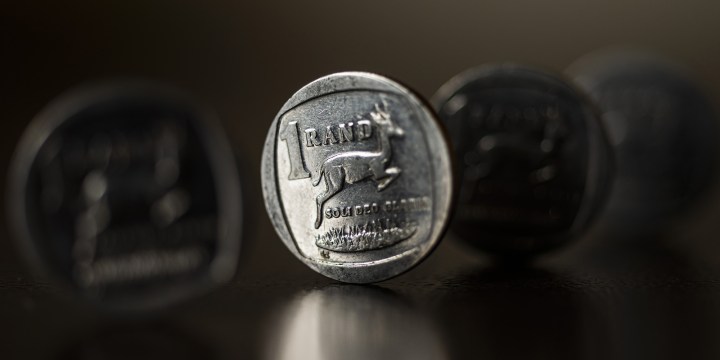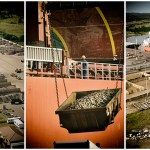BUSINESS REFLECTION
After the Bell: The fall of the rand is emblematic of SA’s economic malaise

So here the rand stands, staring down a twin-barrelled shotgun that threatens to blast it to record lows. And there are other barrels pointing its way.
The rand, you may have noticed, has been taking a beating of note of late. Fetching 18.62/dlr in late afternoon trade on Wednesday, the currency was last at these levels in May 2020, when the economy was melting down under the initial lockdowns to contain the Covid-19 pandemic. That brings it within strolling distance of its record low of 19.03/dlr that was plumbed in April 2020, the hardest of the hardest lockdown months.
With this in mind, it is worth noting the performance of Eskom then and now.
The last time the rand was at these levels, there were no rolling power cuts. That’s because economic activity had ground to almost a standstill under the weight of the lockdowns. Eskom would probably work just fine if this economy was much smaller. The way things are going, that is not a wildly implausible scenario: once this economy is cut back to the size it was a couple of decades ago, the lights may just stay on. As was the case a couple of decades ago.
Today, we have the opposite situation. The mounting toll on the economy and confidence wrought by the power shortages is the key factor undermining the rand. That alone is taking a wrecking ball to any hopes of economic growth and the support this would provide to the rand’s value.
Federal Reserve
But the surge in the level of power cuts the past few months is also taking place against the backdrop of a hawkish Federal Reserve which has been hiking rates furiously to cool inflation in the world’s largest economy. Federal Reserve Chair Jerome Powell told US legislators on Tuesday that the US central bank would probably maintain tightening at a faster pace than previously anticipated, warning that the 2% target “has a long way to go”. The US inflation rate is currently 6.4%.
That is a devastating combination that has left the rand on the ropes.
The latest decline began on Tuesday after the release of the Q4 gross domestic product (GDP) data at midday. The data showed that the economy contracted by 1.3% in Q4, against market expectations of a contraction of 0.4%. That scale of that contraction was a reflection of the ramped-up level of power cuts to keep the grid from a complete collapse, and underscored how economists have consistently underestimated the damaging impact the electricity crisis has inflicted on the economy.
And given the sustained onslaught of rolling blackouts so far this year, it means the economy is in recession — defined as two straight quarters of GDP contraction. There is simply no way that the economy has not continued withering in the face of the outages.
Visit Daily Maverick’s home page for more news, analysis and investigations
The rand was trading at around 18.25/dlr at the time the data were released, and that got things rolling. The rand lost about 0.5% of its value against the dollar within a matter of minutes. And then later in the day, Powell made his comments, triggering a dollar rally that brought the greenback to a three-month high against a basket of currencies, pummelling the rand further in the process.
It went as low as 18.72/dlr at one point, before clawing back a bit of lost ground.
So here the rand stands, staring down a twin-barrelled shotgun that threatens to blast it to record lows. And there are other barrels pointing its way.
There is the whole greylisting matter, which is a big red flag to investors who are concerned about things such as money laundering, terrorist financing, and (nuclear) proliferation financing. ESGs, or environmental, social and governance concerns, are all the rage these days, and reducing exposure to jurisdictions seen as risky on these fronts fits with that governance model.
Then there are all of the other examples of state failure in South Africa beyond the shambles that is Eskom — Transnet, water provision, policy paralysis and confusion, and safety and security. This has undermined economic growth. Throw in the rising risk of social unrest in the world’s most unequal society, and your investment case looks pretty threadbare. And without a convincing investment case, your currency is not going to have a lot going for it.
The currency also seemed to be getting what chartists term “technical support” around the 18.20 to 18.40 levels, and those have been decisively broken. In layperson’s terms, that makes the path to 19/dlr a lot easier.
No upside
Beyond a boost to mining companies that still have operational assets here and other exporters — not to mention foreign tourists who will find this place a bargain, unless they get mugged — there is no upside to the rand’s current downside. And even exporters will feel the pinch as the cost of the imports that sustain their businesses rises.
The Fed’s hawkishness will force the hand of the South African Reserve Bank (Sarb) to maintain its rate hikes when its Monetary Policy Committee (MPC) meets later this month. It simply has no choice if it wants to protect the value of the rand. South African rates need to be much higher than those in the US to make the currency attractive.
On a related issue, the Sarb has its own inflation concerns, and the weakening rand will fuel import inflation at a time when the CPI is running at 6.9% — still well outside the Sarb’s 3% to 6% target range.
But raising rates in the middle of a recession is hardly a recipe for reigniting economic growth. The Sarb has already hiked eight consecutive times, bringing its key repo rate to 7.25% from 3.5% and the prime rate to 10.75%. This will squeeze hard-pressed consumers further while adding to the costs of indebted businesses.
The rand at the moment is emblematic of South Africa’s wider economic malaise while its woes are simultaneously compounding this misery. DM/BM


















Likely scenario:
1) Internal population exchange (shift from defaulting to still working provinces, notably the WC) will accelerate
2) Property values in target provinces will go up until a tipping point is reached. What follows is a rapid decline in stability as things start to break (infrastructure and societal cohesion) and a decline in property and other values
3) Tourists will come until a point where things other than electricity run out (water in particular)
4) Chaos at the political level is going to increase
5) Decline is going to accelerate
Thank you Ed an excellent summary of the situation, I always enjoy reading your articles.
No one else to blame for the shambles we’re in, but the the glorious movement & their industrial scale looting & pillaging. Of course let’s also not forget their decrepit, failed Marxist economic theories & the associated rhetoric.
This country had so much potential…..
I would also not be surprised if we are economically punished for our foreign ‘policy’ of siding with Putin and other despotic regimes. Our government’s inability to identify the goose who lays the golden eggs is stupefying. And to try and hide our associations with other criminal states under a cloak of principal takes us for idiots. Which we are if we don’t manage to vote them out.